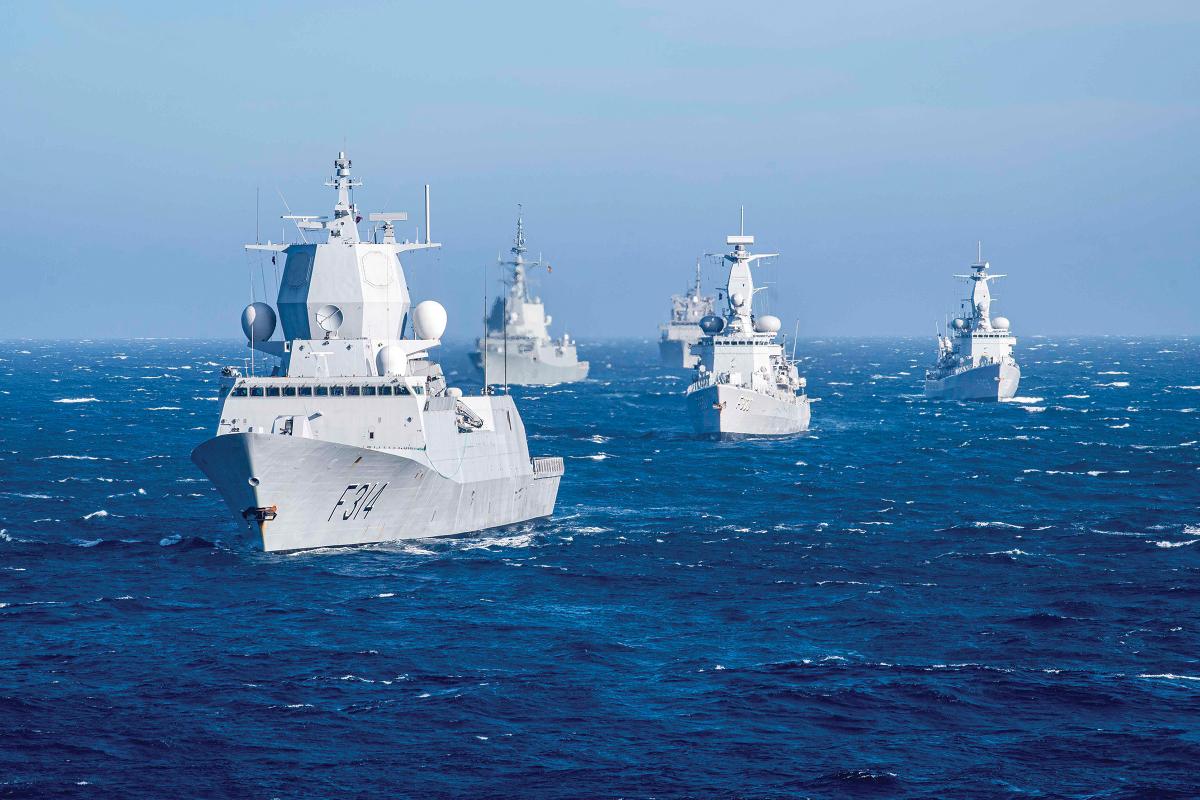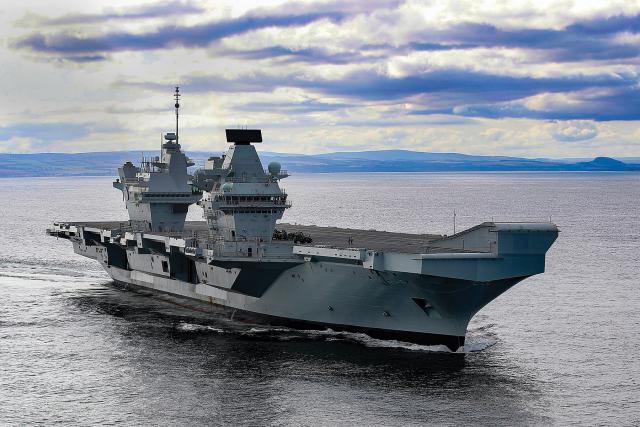The NATO alliance celebrated its 70th anniversary in 2019, providing all 29 members an opportunity to look back at the most successful alliance in history. To counter future threats, the alliance has a wide array of tools at its disposal, and among the most powerful of these are maritime forces. NATO maritime groups, multinational naval operations, and exercises—including Sea Guardian, Dynamic Mariner 2019, and Formidable Shield 2019—help build strong alliance linkages, enhance trust and interoperability among its members, and pave the way for future successes.
Although the United States may provide the lion’s share of capabilities in many areas—including transport aircraft, air-to-air refueling tankers, intelligence, surveillance, and drones—NATO’s naval capabilities are arguably spread more evenly and offer an encouraging example of burden sharing among alliance members. The demand for collective maritime readiness—in the form of increased operational tempo and requirements for antisubmarine, antisurface, air defense, mine countermeasures, and humanitarian assistance/disaster relief—is growing. The non-U.S. members of NATO are providing a growing assortment of highly capable and sometimes unique naval capabilities to meet these demands.
Beyond conventional naval missions, a unified NATO is increasing its investment in cyber, artificial intelligence, unmanned platforms, space, and autonomous capabilities to achieve tomorrow’s maritime victories. Encompassing naval forces that are undoubtedly among the most highly trained and technologically advanced in the world, the NATO alliance is in an excellent position to meet the challenges of the next generation—if it properly funds its military requirements and stays united with common goals. A small sampling of some important efforts to improve these capabilities follows.
Belgium and the Netherlands have begun a new acquisition plan to build 12 mine countermeasures vessels, with six being ordered by each. Current plans call for Belgium to receive the first new mine hunters in 2023, while the Netherlands will begin receiving them the following year. The Netherlands also remains committed to procuring a new class of diesel submarines, with a contract award expected during the next few years.
Canada has increased its submarine deployments and is recapitalizing its surface fleet. In the near term, the first Harry DeWolf–class Arctic and offshore patrol ship will be delivered in 2020, with at least five more planned. Construction is also under way on the Royal Canadian Navy’s two new Protecteur-class replenishment ships scheduled for delivery by 2025. A future program for 15 surface combatants is to begin in the mid-to-late 2020s to replace Canada’s existing frigates and destroyers.
Germany plans to add at least one new surface or subsurface asset to its fleet each year for the next decade. The Baden-Württemberg, namesake of a new four-ship class of Type 125 frigates, was commissioned 17 June 2019, and all four of the 7,200-ton warships are due for delivery by 2021. Germany also plans to acquire at least four new 9,000-ton MKS 180 modular multipurpose surface combatants capable of conducting a wide array of maritime operations, with delivery of the first unit planned for the late 2020s. In 2019, the German government announced plans for two Type 707 double-hulled 20,000-ton replenishment ships to begin entering service in 2024.
The future of French undersea warfare was celebrated last summer as the Suffren, first of a new class of six nuclear-powered attack submarines, was launched. The Suffren incorporates improved quieting and detection capabilities and will enter service in the early 2020s. In February 2019, France commissioned the Bretagne, the fifth of eight planned Aquitaine-class frigates built under the Franco-Italian Multi-Mission European Frigates (FREMM) program. Last summer, France also commissioned the Seine offshore support vessel and took delivery of the Garonne, the final two units of the four-ship Loire class, which is able to undertake a wide range of naval security and support capabilities.
In July 2019, Italy’s massive 33,000-ton amphibious ship Trieste was launched as the largest warship built in that country since World War II. Trieste is expected to join the fleet by 2023 and will be able to accommodate more than 1,000 personnel, a well deck for landing craft, and a 755-foot flight deck for helicopters and F-35B strike-fighter operations. In 2019, Italy launched Paolo Thaon di Revel, the first of seven large multipurpose offshore patrol ships expected for delivery beginning in 2021. The Antonio Marceglia, the eighth of ten planned Italian FREMM ships, was delivered in 2019. Italy’s undersea capabilities also will receive a boost in the mid-2020s with the delivery of four additional Type 212 air-independent-propulsion submarines to be built domestically under license from Germany.
Spain’s ongoing naval acquisition efforts are aimed at enhancing its air-defense, patrol, and undersea capabilities. Delivery of five advanced Aegis-equipped F-110 air-defense frigates is set to take place between 2025 and 2031. Spain’s sixth Meteoro-class modular maritime action offshore patrol vessel, the Furor, was delivered in early 2019, and plans call for acquisition of three additional units in the future. The problem-plagued S-80 Isaac Peral submarine program remains a national priority for Spain. Despite technical challenges, the namesake of these next-generation Spanish-built submarines is expected for delivery in December 2022.
Turkey’s controversial policies, including the country’s recent acquisition of Russian S-400 surface-to-air missiles, have resulted in its removal from the multinational F-35 fighter program and cast a shadow over its relationship with NATO. Turkey’s maritime forces are improving their power-projection capabilities through the construction of Anadolu, a domestically built 28,000-ton big-deck amphibious assault ship based on Spain’s Juan Carlos I class. Expected for delivery by 2021, the warship can carry heavy assault forces, humanitarian assistance, or a mix of two dozen helicopters, and—potentially—fixed-wing very-short-takeoff fighters when configured as a light aircraft carrier. Turkey’s fourth Heybeliada-class corvette, the Kinaliada, entered service in the fall of 2019, and the first of a larger Istanbul-class variant is expected to enter service in 2021. In the long term, Turkey hopes to build a new class of advanced air-defense frigates and plans to build six German-designed Type 214 submarines domestically by the 2040s.
As the United Kingdom withdraws from the European Union, British linkages with NATO and the United States will become increasingly important. At the core of British military power lies the Royal Navy, and for the first time in decades the fleet includes two full-size aircraft carriers. On 10 December 2019, HMS Prince of Wales, the second 65,000-ton Queen Elizabeth–class carrier, was commissioned. She is expected to be fully operational by 2023.
The Queen Elizabeth conducted operational trials with F-35B Lightning fighters late in 2019, and in June last year, British F-35Bs saw their first combat operations over the skies of Syria and Iraq. The Queen Elizabeth is expected to reach initial operational capability later this year. As a testament to the U.S.-U.K. “special relationship,” the “QE” will operate a mix of F-35Bs from the United Kingdom and U.S. Marine Corps during her initial 2021 deployment. Military planners intend for the two British carriers, which can carry more than 50 F-35Bs and helicopters, to be interchangeable with U.S. aircraft carriers, helping to share a burden long borne mainly by the U.S. Navy’s nuclear-powered supercarriers.
The Royal Navy’s fourth Astute-class nuclear submarine, Audacious, will enter the fleet in January 2021, and production is ramping up on Britain’s next generation Dreadnought-class nuclear-powered ballistic-missile submarines. Four of the 17,000-ton submarines are planned for the 2030s.
The United Kingdom began taking deliveries of its first P-8A Poseidon maritime patrol aircraft this past November. All nine P-8s are expected by 2021, helping plug a decade-long maritime patrol gap that was brought about by cancellation of the Nimrod MRA4 in 2010.
In August 2019, construction began on the second of eight planned City-class (Type 26) antisubmarine frigates, to be named Cardiff. First-in-class HMS Glasgow is to be delivered in 2023. A new class of Type 31 general-purpose frigates, to be based on Denmark’s Iver Huitfeldt–class, is planned under a rapid acquisition schedule that calls for production to begin in 2021, with the first slated to enter service in 2027.
Looking to the future, NATO faces a new generation of threats ranging from peer and near-peer competitors, rogue actors, extremists, and terrorists, to the alliance’s own internal nationalist pressures. Yet despite these challenges, NATO’s maritime forces are working together—growing in power and capability and laying the groundwork for the alliance’s next 70 years.




